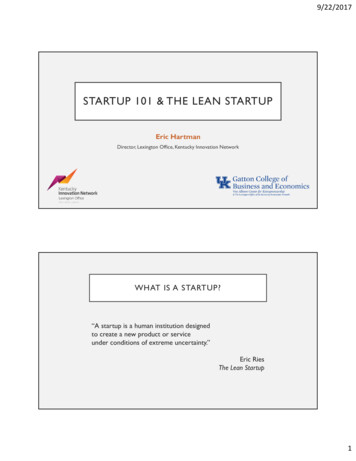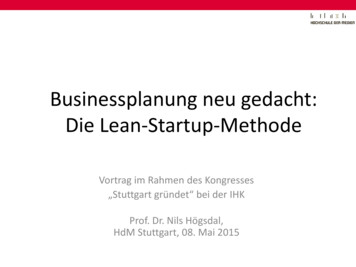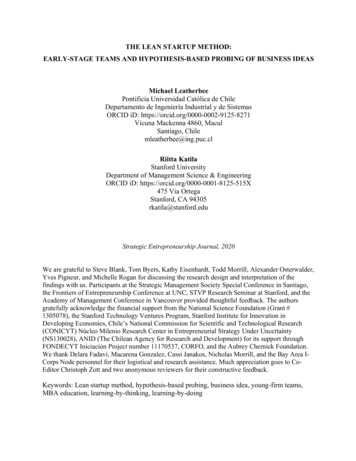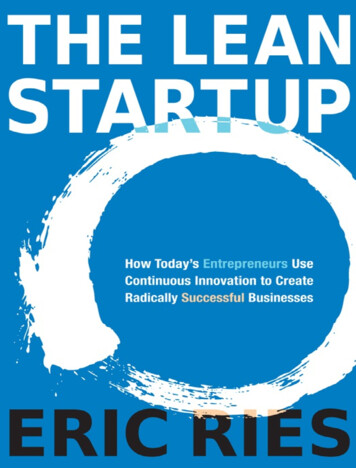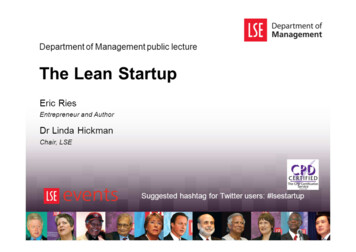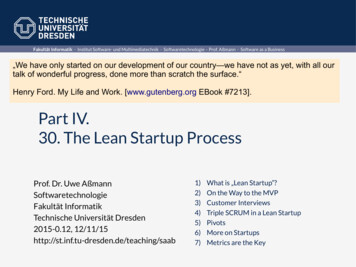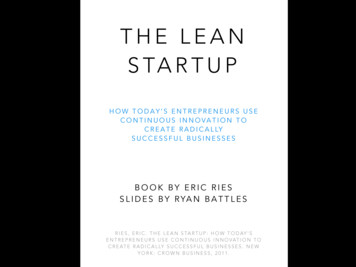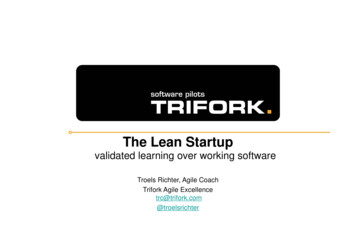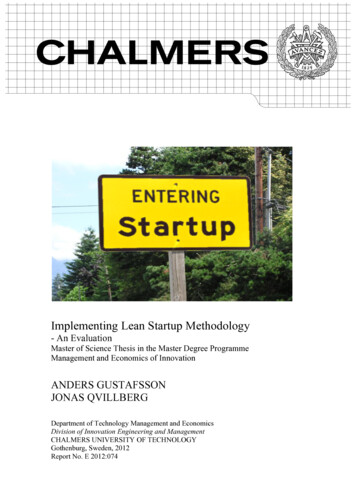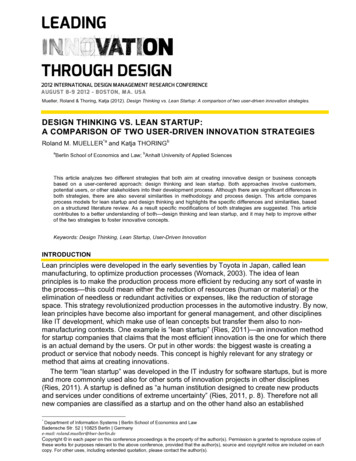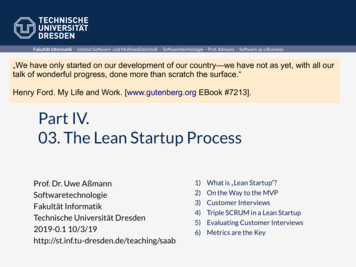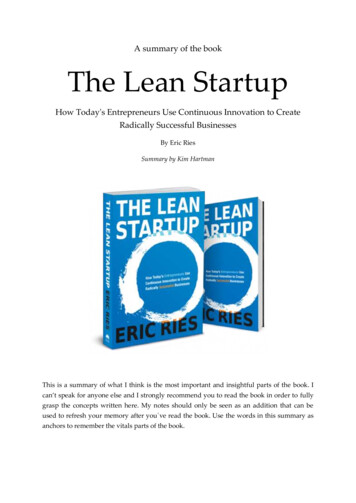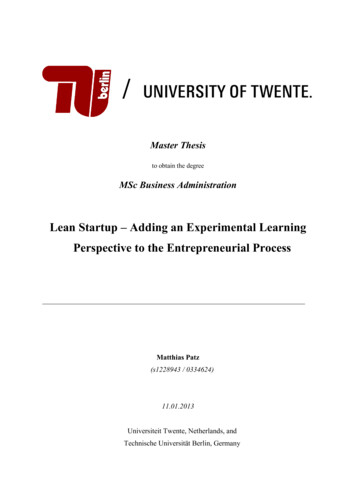
Transcription
/Master Thesisto obtain the degreeMSc Business AdministrationLean Startup – Adding an Experimental LearningPerspective to the Entrepreneurial ProcessMatthias Patz(s1228943 / 0334624)11.01.2013Universiteit Twente, Netherlands, andTechnische Universität Berlin, Germany
iStatutory DeclarationI declare that I have authored this thesis independently, that I have not used other than thedeclared sources / resources, and that I have explicitly marked all material which has beenquoted either literally or by content from the used sources.DateMatthias Patz
iiManagement SummarySometimes, there are methods applied in reality that are overlooked by researchers. In thecase of this research project, the phenomenon of Lean Startup has been empiricallyinvestigated. Lean Startup rejoices increasing popularity amongst entrepreneurs in SiliconValley and meanwhile in over 90 countries all over the world. Being a synthesis of agiledevelopment techniques and market research methods, Lean Startup helps people tosuccessfully develop innovative products and services in a close relationship with customers.The core element is a cyclic procedure consisting of the phases: build, measure, and learn.A literature review in the domain of organization theory, especially entrepreneurship,organizational learning, and new product development has been undertaken to get anoverview about scientific models that are similar to Lean Startup. Following, Effectuation andBricolage, as entrepreneurial process models, the conception of learning sequences and thelead user concept have been extracted for further analysis.Getting an in-depth understanding of the phenomenon under investigation, a qualitativephenomenological research approach was chosen. In total, eight interviews with Lean Startuppractitioners and professionals have been conducted. The interview transcripts weresynthesized and aggregated on the basis of a grounded theory approach. Applying open andaxial coding, as well as subjective sense-making revealed 25 concepts related to Lean Startup.To identify meaningful relationships, computer-assisted methods have been appliedadditionally.The results show, that the observed build-measure-learn feedback loop is echoed in the codedinterview data. Therefore, it can be said that the fundamental elements of Lean Startup arelearning, prototyping, running experiments and validating initial business assumptions.Moreover, the discussion and comparison with existing scientific methods show that theconcept of learning is not yet incorporated adequately. Learning and uncertainty reduction inthe opportunity development phase offer great potential for new insights by the Lean Startupmethodology.All in all, the research demonstrates effectively that the interplay between theory and practicecan reveal interesting insights for practice and future direction for theoretical elaboration.
iiiContent1. Introduction . 12. Theoretical Anticipation . 42.1. Lean Startup – A Popular Science Phenomenon . 42.2. Engaged Scholarship – From Practice to Academia . 72.3. Theory Development – For a Sound Contribution to Research . 82.4. Entrepreneurial Processes – Examples of Opportunity Creation Approaches . 92.5. Organizational Learning – Adapting to Environmental Changes. 112.6. New Product Development – Adding the Customer Perspective . 132.7. Phenomenology – A Research Design to Capture the Pure Essence . 143. Methodology . 163.1. Methodological Motivation . 163.2. Research Design . 183.3. Data Collection . 203.4. Data Analysis . 234. Results . 264.1. The Big Picture . 264.2. Lean Startup as an Adaptable Methodology. 294.3. Learning as the Essence of Lean Startup . 324.4. Last but Not Least, the Outliers . 405. Discussion . 426. Conclusion . 486.1. Major Contribution of this Work . 486.2. Theoretical and Managerial Implications . 496.3. Limitations and Further Research Directions . 507. References. 518. Appendix – Interview Guideline . 61
ivFiguresFigure 1 - Build-Measure-Learn Feedback Loop . 5Figure 2 - Data Analysis and Aggregation Process . 26Figure 3 - Co-Occurrence Matrix . 27Figure 4 - Breakdown of Co-Occurrence Matrix . 28Figure 5 - Visualization of Lean Startup Methodology . 34Figure 6 - Visualization of Build-Measure-Learn Feedback Loop within the Lean StartupMethodology . 35Figure 7 - Framework of Discussion . 42TablesTable 1 - Comparison of Research Designs . 17Table 2 - Cluster Composition: Lean Startup Essentials . 29Table 3 – Aggregated Coding Table: Lean Startup Essentials . 31Table 4 - Cluster Composition: Lean Startup Methodology . 33Table 5 - Aggregated Coding Table: Lean Startup Methodology . 39Table 6 - Concept Composition: Risk and Product Development. 40Table 7 - Aggregated Coding Table: Risk and Product Development . 41Table 8 - Summary of Literature Streams and Research Findings . 47
11. Introduction“From the perspective of Technical Rationality, professional practice is a process of problemsolving. Problems of choice or decision are solved through the selection, from availablemeans, of the one best suited to establish ends. But with this emphasis on problem solving, weignore problem setting, the process by which we define the decision to be made, the ends to beachieved, the means which may be chosen. In real-world practice, problems do not presentthemselves to the practitioner as givens. They must be constructed from the materials ofproblem situations which are puzzling, troubling, and uncertain.” (Schön, 1983, pp. 39–40)I am a practitioner.Entrepreneurship as an academic research domain dates back to Schumpeter (1934) and hisunderstanding of an innovative individual who disrupts markets, the Entrepreneur. It is stillconsidered very volatile in terms of a common understanding or convergence (Grant & Perrin,2002). This is due to the fact, that Entrepreneurship borrows concepts from a variety ofrelated research fields, such as decision science, economics, management, sociology, andpsychology, thereby making it impossible to develop the one complete and concerted theory(Amit, Glosten, & Muller, 2007; Gartner, 2001).One major element within the field of Entrepreneurship is the concept of an opportunity. Itsemphasis lies on innovation, novelty, and the creation of new means-ends relationships(Davidsson, 2008; Shane & Venkataraman, 2000; Shane, 2003). The quest or activityundertaken to find, form and exploit opportunities can be labeled as entrepreneurial action andis divided into two different camps. On the one hand, market imperfections will exogenouslyarise e.g. through changes in technology, market environments or customer needs and need tobe found by entrepreneurs; this is termed “discovery theory”. On the other hand, “creationtheory” assumes that opportunities are co-created (Aldrich & Ruef, 2006; Alvarez & Barney,2007). Assuming that not all entrepreneurial opportunities arise through any change in theecosystem, but are instead co-created through an entrepreneurial process of sorts,entrepreneurs’ actions are brought into focus by the latter interpretation. Following the stringof thought of an entrepreneurial process, Sarasvathy and Venkataraman (2011, p. 117) raisedthe open question “What do entrepreneurs actually do?” to motivate researcher to investigateon that subject. The quest on opportunity discovery and exploitation from a processperspective in Entrepreneurship is also shared by other scholars (Shane & Venkataraman,2000; Ucbasaran, Westhead, & Wright, 2001; Wiklund, Davidsson, Audretsch, & Karlsson,
22011). In other words, a shift of focus towards specific actions undertaken by entrepreneurs topursue opportunities can be noticed in the research domain of Entrepreneurship.This brings me back to my first sentence: I am a practitioner. Based on this perspective inbuilding upon social phenomena and the interaction within a real-life context, it is argued thatEntrepreneurship could be researched using methodologies that are focused on things – onreal-life occurrences- and how those are experienced and dealt with in order to explore newinsights (Berglund, 2006; Hummel, 1991). Therefore, I have dedicated my research to aparticular practical phenomenon within the context of the Entrepreneurship domain – LeanStartup.Since 2008, the methodology of Lean Startup has been enjoying ever increasing popularityamongst entrepreneurs all over the world. Initially, it started as a best-practice of a companyin Silicon Valley, San Francisco, USA, and finally emerged into a methodology facilitatingentrepreneurs to successfully create an innovative venture. Meanwhile, there are meetingstaking place on a regular basis in more than 94 cities worldwide. Moreover, the most recentpopular science book on the topic has already sold over 90,000 copies. Lean Startup asmethod is “the application of lean thinking to the process of innovation” (Ries, 2011, p. 6).The underlying principles of Lean Startup are based on the lean manufacturing approach byToyota including customer centricity and value, as well as continuous flow and improvisation(Ohno, 1988; Womack, Jones, & Roos, 1991). The method itself makes use of iterative oragile product development in small chunks with a focus on experimental learning. In otherwords, assumptions about the business model hypotheses need to be validated in goal-orientedexperiments (Blank & Dorf, 2012; Blank, 2006). To accomplish those experiments, agiledevelopment techniques are used which are symbolized in the so called “build-measure-learnfeedback loop”.Research on the literature for “lean startup” in particular and also for a combination ofkeywords (e.g. “(agile OR lean) AND entrepreneur*”, “(agile OR lean) AND (startup OR"start-up")”) does not yield any results via Thomas Reuters’ “Web of Knowledge”.Nevertheless, there are theoretical concepts in the field of organization theory that showcertain similarities with the method of Lean Startup. First of all, some teleological processmodels from the Entrepreneurship research domain, for example Effectuation (Sarasvathy,2001; Wiltbank, Dew, Read, & Sarasvathy, 2006) and Bricolage (Baker & Nelson, 2005;Garud & Karnøe, 2003) follow an approach of social or environmental interaction towardsopportunity development. Teleological theories are characterized by envisioning a certain end
3state. To reach the aspired goal no prescribed paths are given. Instead, multiple options areoffered through creativity and purposeful cooperation (Van de Ven & Poole, 1995). Secondly,experimental learning models from the organizational literature stream seem to be reflected inthe Lean Startup method (Bingham & Davis, 2012; Lumpkin & Lichtenstein, 2005). Finally,thoughts of new product development processes under high uncertainty and ambiguityresemble the phenomenon under investigation (Hippel, 1986; Lettl, Herstatt, & Gemuenden,2006; Slater & Mohr, 2006)Specifically, an emerging popular phenomenon from the real-world has been identified buthas not yet received adequate consideration in academic journals or literature nor is it tangiblefrom a
Lean Startup is compared to the models introduced in the theory part to clarify gaps and overlaps. Finally, the most important implications, limitations and suggestions for future research are outlined. 4 2. Theoretical Anticipation 2.1. Lean Startup .
